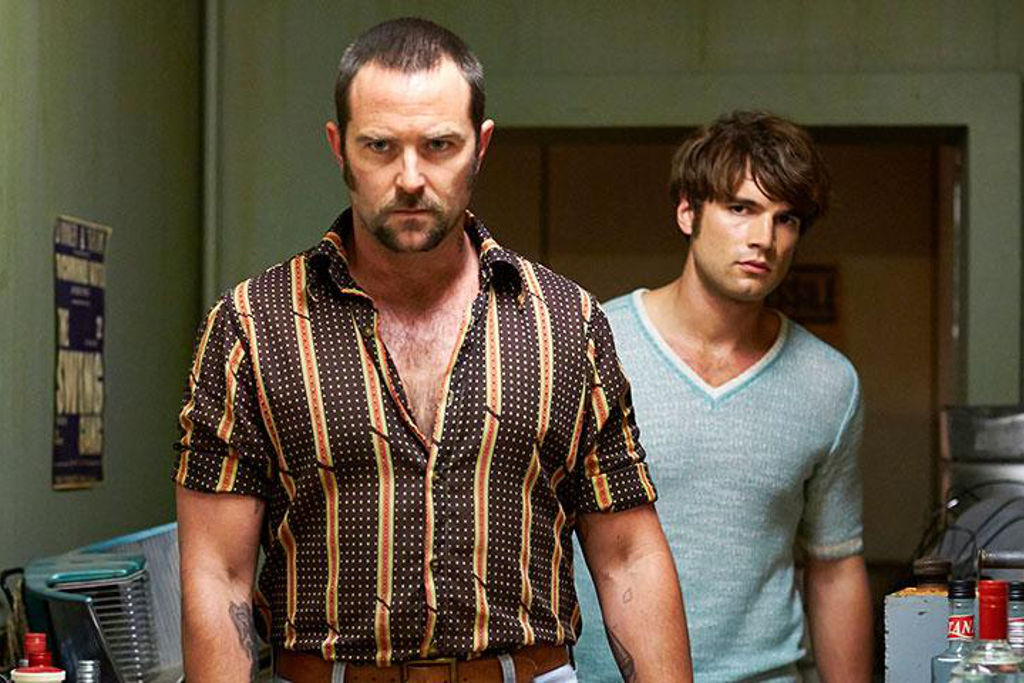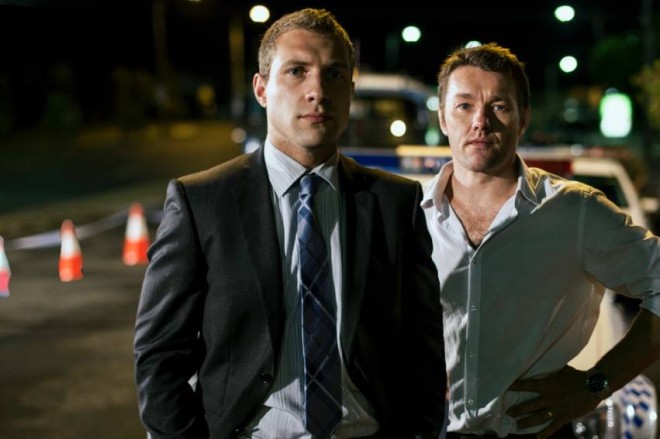What Do These Three Melbourne Film Festival Premieres Say About the State of Australian Film?
Predestination, Cut Snake and Felony demonstrate that there’s enough room in the industry, and enough talent, for Australian cinema to stand together.

The seventeen-day march of cinema that is the Melbourne International Film Festival rumbled to a halt in mid-August, finally allowing its newly enfeebled audience the chance to catch their breath, close their eyes, and take stock.
The festival boasted a multitude of Australian content this year, along with a few local premieres, none of which were more high profile than the three films shown at the festival galas. The opening night screening was the Australian premiere of Predestination, a time travel thriller starring Ethan Hawke, which received good notices out of Texas’ SxSW. The mid-festival Centrepiece event was the premiere of Cut Snake, a crime thriller from Tony Ayres (The Home Song Stories, The Slap), and the closing night event boasted the national debut of Felony, Joel Edgerton’s new cop drama.
Aussie films are often stacked up against their international cousins, both artistically and at the box office — and mostly, they lose out. But what happens when we stack them up against each other?
–
Predestination
Directed by: Michael and Peter Spierig
Starring: Ethan Hawke, Sarah Snook
This time travel head-trip has been loosely adapted by twins Michael and Peter Spierig from the Robert A. Heinlein short story ‘All You Zombies’. Ethan Hawke stars as a ‘Temporal Agent’ charged with hopping through time and stopping grievous crimes before they are committed.
As the film opens, Hawke is hot on the trail of the Fizzle Bomber, a terrorist with a string of devastating attacks to his resume. When Hawke’s attempt to ambush the bomber goes very, very pear-shaped, he is left with a reconstructed face and a new assignment as a bartender in 1970s New York. There, he meets an androgynous young man, played by Aussie actress Sarah Snook, who proceeds to tell him his unusual life story. The connection between these two (and the bomber) turns out—naturally—to be far stranger and more complicated than circumstances would suggest.
The Spierig brothers—who first came to attention in 2003, with the zombie-alien horror hybrid Undead—seem to be cinematic prodigies, and their names are all over the credits here: for directing, writing, producing, even for the digital visual effects (and one brother, Peter, composed the music, as well). Perhaps as a result, Predestination has a hand-made quality that veers between charming and a bit underdone, and its technical limitations show. Presumably restricted by budget concerns, the film confines itself mostly to poky interior locations, while the retro-future style of Hawke’s time travel organisation seems to have been conceived mainly as an excuse to under-dress the set.
The cramped aesthetics contribute to the feeling of incoherence once the story’s time travel paradoxes get hairy — and they get very hairy indeed (also: sexy, sort of). The film’s engagingly warped narrative ambition isn’t quite enough to conceal the fact that it’s also a bit of a hot mess. But it does have an incredible role for Snook—richer in scope than any other lead Australian part so far this year—and she makes the most of her various transformations.
–
Cut Snake
Directed by: Tony Ayres
Starring: Sullivan Stapleton, Alex Russell, Jessica De Gouw
This latest film from Tony Ayres is a psychologically fraught crime drama set in 1970s Australia. When bulky convict Pommie (Sullivan Stapleton) is released from prison, he promptly goes searching for old associate Sparra (Alex Russell) and finds him living the quiet life in the suburbs, with an apprenticeship on the horizon and a new fiancée, Paula (Jessica De Gouw). But Pommie feels he is owed something, and he isn’t one to be dissuaded by the appearance of happy domesticity. Pretty soon Sparra finds himself re-entangled in a life of crime.
For a while, Cut Snake manages to wring something interesting out of this familiar premise, by pushing its emotional and sexual metaphorical resonances right out of the subtext and into the text. But it doesn’t make very effective use of these ideas once they’re exposed. Thankfully, the film has a charismatic lead performance at its core.
As Pommie, Sullivan Stapleton ably projects a combination of emotional sensitivity and brute force that bears some resemblance to Eric Bana’s star-making turn in Chopper. With his crotch-hugging jeans and a shirt open to the sternum, Stapleton exudes sexual menace, and Ayres gets a substantial amount of suspense from bouncing him off Russell and De Gouw. At times it seems like a race to see who he’ll assault first.
After the film makes a midpoint narrative turn (whose nature can be guessed at, although it’s still fun to see unfold), the tension of these early scenes dissipates into something less interesting. Writer Blake Ayshford’s willingness to lay all his screenplay’s cards on the table backfires once its original mysteries have played out, leaving only pretty obvious melodrama in their place. Ayres gets good performances out of the three main players—and the ‘70s aesthetics are well designed, if a little on the nose—but his style is never more than functional. This turns out to be a handicap in the film’s final act, when its lurid content is in bad need of some visual pizzazz.
–
Felony
Directed by: Matthew Saville
Starring: Joel Edgerton, Tom Wilkinson, Jai Courtney
Written by and starring Joel Edgerton, and directed by Noise’s Matthew Saville, Felony is a taut little morality play set amongst the NSW police force. Edgerton plays Malcolm Toohey, a celebrated cop who bumps a kid off his bike while drunk driving home after a successful drug bust. When Detectives Carl Summer (Tom Wilkinson) and Jim Melic (Jai Courtney) show up at the scene, Toohey seizes a chance to conceal his involvement in the accident, with the apparent understanding of Summer, but the growing suspicion of Melic.
As the young boy’s condition worsens in the days that follow, Toohey is torn between his growing moral anguish and his need to keeps things quiet for his family and his fellow cops.
In comparison to Cut Snake and Predestination, Felony looks like it has substantial financial resources at its disposal, which shows in its ability to draw over talent like Wilkinson from his usual American and British film haunts, giving the film a patina of international respectability (of the kind that Ethan Hawke cannot provide Predestination. Sorry, Hawke). Wilkinson delivers with a very effective performance as a hard-living Aussie cop archetype, even if his accent occasionally veers into cockney. This financial luxury also seems present in Saville’s thoughtful, fluid visual style, which uses a multitude of set-ups and perspectives to skillfully articulate the complex web of intrigue surrounding the three men.

Nothing about Felony feels compromised—as so many Australian films do—from a narrative, aesthetic, or production standpoint – which is both a blessing and a curse. Responses to the film in Melbourne, and from its overseas showings, seem to have been muted. But what is there to say about a film that is merely very good? Edgerton’s script eschews the big emotional beat (and it cleverly undercuts its major dramatic confrontation), and instead concentrates its attention on carefully sketching out its narrative tangle with an understated, adult subtlety.
–
Comparing these three films is a neat thought experiment, but the resulting messages are mixed. If Predestination’s story suffers from an excess of ambition, then Felony’s is modest to a fault. Cut Snake falters in its scripting, but it also boasts the kind of dynamic lead role that Felony, for all its tasteful writing and fine performances, does not. Ayres’ direction is too plain, but for all their style the Spierigs don’t get appreciably superior results.
Even though the films differ in quality, there’s a variety to their strengths that is encouraging. These films can speak to each other, and learn things. Under the pressure of arrival, each new Australian film can feel like it’s being pitted against the entire might of international cinema; a contest that’s almost impossible to win. But here we have a crop of films that demonstrate that there’s enough room in the industry, and enough talent, for Australian cinema to stand together.
One okay film feels like a missed opportunity. But three okay films: that’s a trend.
–
James Robert Douglas is a freelance writer and critic, and interviews editor for The Lifted Brow. He tweets from @jamesrobdouglas.